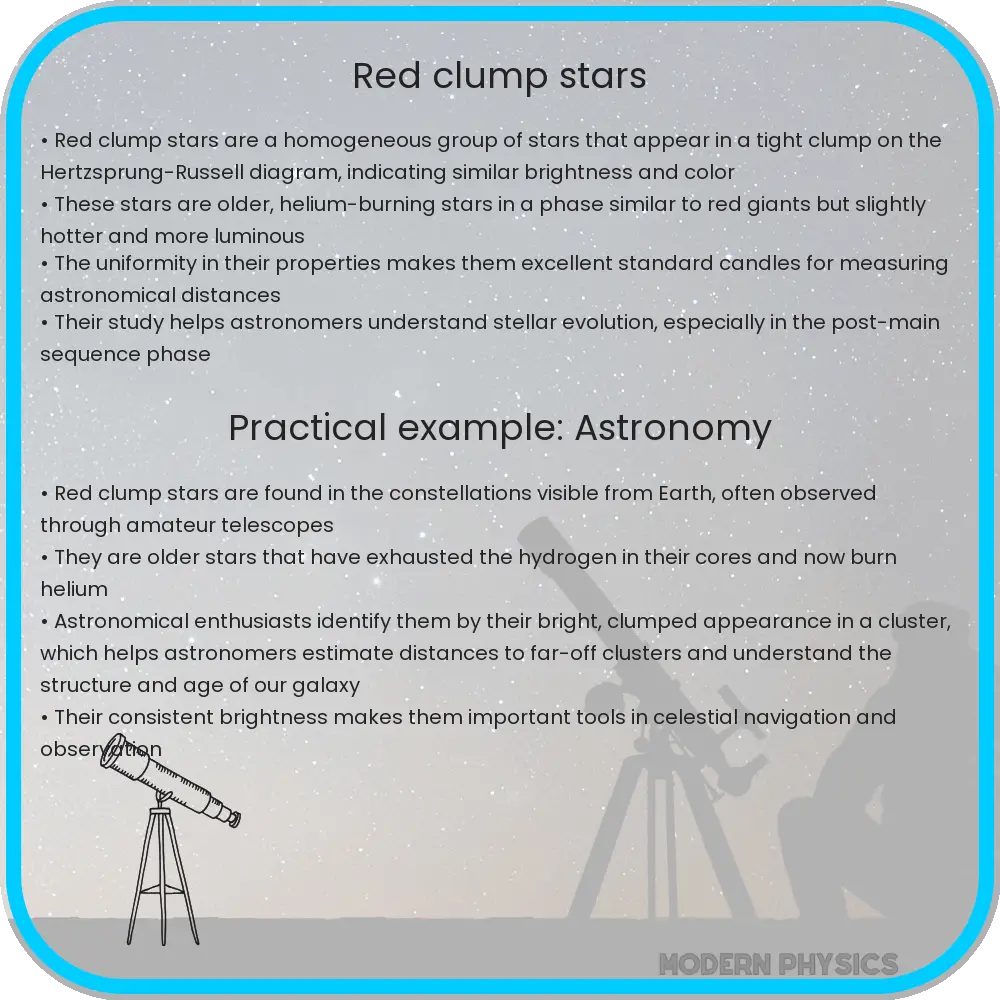Explore the fascinating world of Red Clump stars, their characteristics, evolution, and crucial role in measuring cosmic distances and understanding galactic structures.

Understanding Red Clump Stars
Red Clump (RC) stars are an important class of stellar objects in astrophysics, known for their distinct position in the Hertzsprung-Russell (H-R) diagram. These stars represent a phase in stellar evolution that occurs after a star has exhausted the hydrogen at its core and before it evolves into a red giant or supergiant. Understanding the characteristics, evolution, and significance of Red Clump stars can provide crucial insights into the life cycles of stars and the dynamics of our galaxy.
Characteristics of Red Clump Stars
Red Clump stars are characterized by their moderate brightness and red color, which is a result of their relatively cool surface temperatures, typically around 4,500 to 5,500 K. These stars are primarily found in the ‘clump’ region of the H-R diagram, where they clump together, hence their name. This clustering occurs because the stars in this phase have similar luminosities and temperatures, making them an important standard candle for astronomical measurements.
Evolution into Red Clump Stars
The journey of a star into the Red Clump phase begins once it exhausts the hydrogen fuel in its core. After the main sequence phase, the star expands and cools to become a red giant. In the cores of these expanding stars, helium accumulates, and the temperature and pressure increase until they reach a critical point where helium fusion begins in a process known as the helium flash. This event marks the transition from the red giant branch to the horizontal branch or Red Clump for stars of low to intermediate mass (approximately 0.5 to 2.3 M☉).
Brightness and Lifespan
The intrinsic brightness of Red Clump stars is notably stable, with luminosities around 50 times that of the Sun. This stability, combined with their well-defined position in the H-R diagram, makes them excellent distance indicators in astronomy. The typical lifespan of a Red Clump star in this stable phase is around 100 million to 2 billion years, depending on the star’s initial mass and composition.
Importance in Astrophysics
Red Clump stars hold a special place in the field of astrophysics. Due to their uniform brightness, they serve as reliable standard candles, aiding in the measurement of distances to galaxies and the mapping of galactic structures. Additionally, their abundance and evolutionary status make them ideal targets for studying the chemical composition and dynamics of stellar populations across the Milky Way.
Chemical Composition and Internal Structure
The internal structure of Red Clump stars is characterized by a helium-burning core surrounded by a thin shell where hydrogen continues to fuse into helium. The chemical composition of these stars varies depending on their initial mass and the environment in which they were formed. Typically, Red Clump stars exhibit enhanced levels of elements heavier than hydrogen and helium, known as ‘metals’ in astronomical terms. This metallicity affects their color and brightness and can provide valuable information about the star’s age and the chemical evolution of its host galaxy.
Role in Galactic Archaeology
Red Clump stars are not just important for understanding stellar evolution; they also play a crucial role in galactic archaeology. By studying the distribution and properties of Red Clump stars in the Milky Way, astronomers can reconstruct the history of our galaxy. These stars act as tracers, helping scientists to map out the structure, age, and formation of the galactic disk, bulge, and halo. This research contributes significantly to our understanding of the Milky Way’s past and its dynamic processes.
Challenges and Future Research
Despite their importance, Red Clump stars are not without their mysteries. One of the ongoing challenges in studying these stars is accurately determining their ages, as age estimates can be affected by factors such as metallicity and helium content. Future research aims to refine the methods used to estimate the ages and distances of Red Clump stars, improving our understanding of the galaxy and the universe as a whole. Additionally, ongoing and future space missions are expected to discover and analyze many more Red Clump stars, providing a wealth of data for astronomers and astrophysicists.
Conclusion
Red Clump stars serve as a cornerstone in the field of astrophysics, offering insights into stellar evolution, galactic structure, and the history of the universe. Their stable brightness and distinct position in the H-R diagram make them invaluable as standard candles for measuring cosmic distances. Moreover, their role in galactic archaeology helps unravel the complex history and dynamics of galaxies. As research advances and observational technologies improve, Red Clump stars will continue to shed light on the mysteries of the cosmos, guiding our understanding of the celestial landscape and its myriad phenomena.
